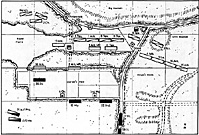Background
Having forced the Confederates to retreat from Missouri, Union General Sam Curtis found himself camped in northeastern Arkansas at the end of a very long and tenuous supply line. Although anxious, Curtis was determined to hold his ground and prevent the Confederates from reentering Missouri. To this end, he deployed his army along Little Sugar Creek in order to block the main road north.
Rebel firebrand, Major General Earl Van Dorn, was given overall control of the two main Confederate forces in the area, "Pap" Price's Missourians and Ben McCulloch's Arkansans. Van Dorn's plan was simply to march around the Federal position and place himself astride its lines of communication with Missouri, forcing the Federals to either surrender or fight on his terms. Van Dorn, however, ignored basic military preparations for his grand scheme and led a tired, hungry and ill-equipped army through a frozen wilderness.
On the morning of March 7, Van Dorn decided to split his command in two. Price would take a northern path to Elkhorn Tavern, the rendezvous point, while McCulloch marched to the south. The Federals, however, had learned of the various moves and were rushing various detachments north from the defenses on Little Sugar Creek.
McCulloch's column was intercepted around noon just north of Leetown, a mere two and a half miles from Elkhorn Tavern. Forced to turn and fight, the Confederate commander and his deputy (McIntosh) were amongst the first casualties. Thereafter, the main body of Rebel troops stood around waiting for orders which never arrived.
The only real chance the Confederates had of victory over the patchwork Union defense came when Louis Herbert led his men through the wood against the Union right. Unsupported by the rest of the army, this offensive was overwhelmed by superior local numbers and Herbert was eventually captured. From 4:00 pm, the Confederate army fragmented into various detachments under different leaders which had all left the field as darkness descended.
The Wargame
The game starts at 12:30 pm, just as the Confederate cavalry forms for its attack on Bussey's troopers and artillerymen. It will become dark on the 7:30 pm turn. Two companies of the 37th Illinois were armed with Colt repeating rifles. Simply put, this means five figures count as having these weapons. This was a particularly harrowing campaign for the Confederates. They began two days of fighting cold, tired and hungry, having lost touch with their supply trains. Despite the hardships, the Rebel soldiers fought as bravely as their Yankee counterparts. Because of this I have not tampered with Confederate morale to try and reflect their suffering. If you disagree, lower all Rebel morale ratings by one.
Deployment
As the map. The units of the Union 3rd Division arrive at 1:45 pm at point A in the following order: 37th Illinois, 59th Illinois, A 2nd Illinois, 18th Indiana.
Terrain
This is fairly heavy with light woods covering most of the ground. Place a few clumps of heavier forest in Morgan's Woods. The fields are open. All slopes and the bottom of the ravine are rough.
Victory Conditions
The Confederates must inflict sixty percent casualties on the Federals. The Federals, of course, must prevent this.
Union Order of Battle
Army of the Southwest
First Division
Colonel P. J. Osterhaus, average, +2
2nd Brigade Colonel N. Greusel, average, +1
-
36th Ill., 640 men, RM, green
12th Mo., 360 men, RM(p), green
Artillery
-
4th Ohio Bty., 4 x 6 lb. JR, 2 x 12 lb. H, green
Welfley's Mo. Bty., 2 x 12 lb. H, 1 x 12 lb. SB, green
3rd Division
Colonel J.C. Davis, average, +2
1st Brigade Colonel T. Pattison, average, +1
-
18th Ind., 460 men, RM, average
2nd Ind., 400 men, RM, average
2nd Brigade Colonel J. White, average, +1
-
37th Ill., 500 men, RM(p)/RR(p), average
59th Ill., 460 men, RM(p), average
Bty. A, 2nd Ill., 2 x 6 lb. JR, 2 x 12 lb. SB, 2 x 12 lb. H, average
Cavalry
Colonel C. White, average, +1
-
3rd Iowa, 200 men, MLC, green
1st Mo., 100 men, MLC, green
4th Mo., 100 men, MLC, green
5th Mo., 100 men, MLC, green
Confederate Order of Battle
Army of the West
McCulloch's Division
Brig. Gen. B. McCulloch, average, +2
Hebert's Brigade Colonel L. Hebert, average, +1
-
4th Ark., 600 men, RM, average
14th Ark., 500 men, SB, green
15th Ark., 300 men, RM, average
16th Ark., 360 men, RM, green
17th Ark., 400 men, SB, green
1st Ark. Mtd. Rifles (dsmtd.), 600 men, RM, average
2nd Ark. Mtd. Rifles (dsmtd.), 700 men, RM, average
3rd La., 500 men, RM, elite
4th Texas Cav. Btn. (dsmtd.), 200 men, RM, green
Mcintosh's Cavalry Brigade Brig. Gen. J. M. McIntosh, average, +1
-
3rd Texas, 600 men, SH, average
6th Texas, 700 men, SB, green
9th Texas, 600 men, SB, green
11th Texas, 500 men, SH, average
1st Ark. Btn., 300 men, RM, green
1st Texas Btn., 300 men, SH average
Artillery
- Gaines' Ark. Bty., 2 x 12 lb. JR, 2 x 12 lb. H, green
Hart's Ark. Bty., 4 x 6 lb. SB, green
Provence's Ark. Bty., 2 x 6 lb. SB, 2 x 12 lb. H, green
Good's Texas Bty., 4 x 12 lb. SB, 2 x 12 lb. H, green
Pike's Indian Brigade Brig. Gen. A. J. Pike, average, +1
-
1st Cherokee Mtd. Rifles, 400 men, SH, green
2nd Cherokee Mtd. Rifles, 400 men, SH, green
Welch's Texas Cav. Squadron, 100 men, RM, green

Related
Back to The Zouave Vol IX No. 1 Table of Contents
Back to The Zouave List of Issues
Back to Master Magazine List
© Copyright 1995 The American Civil War Society
This article appears in MagWeb (Magazine Web) on the Internet World Wide Web.
Other military history articles and gaming articles are available at http://www.magweb.com